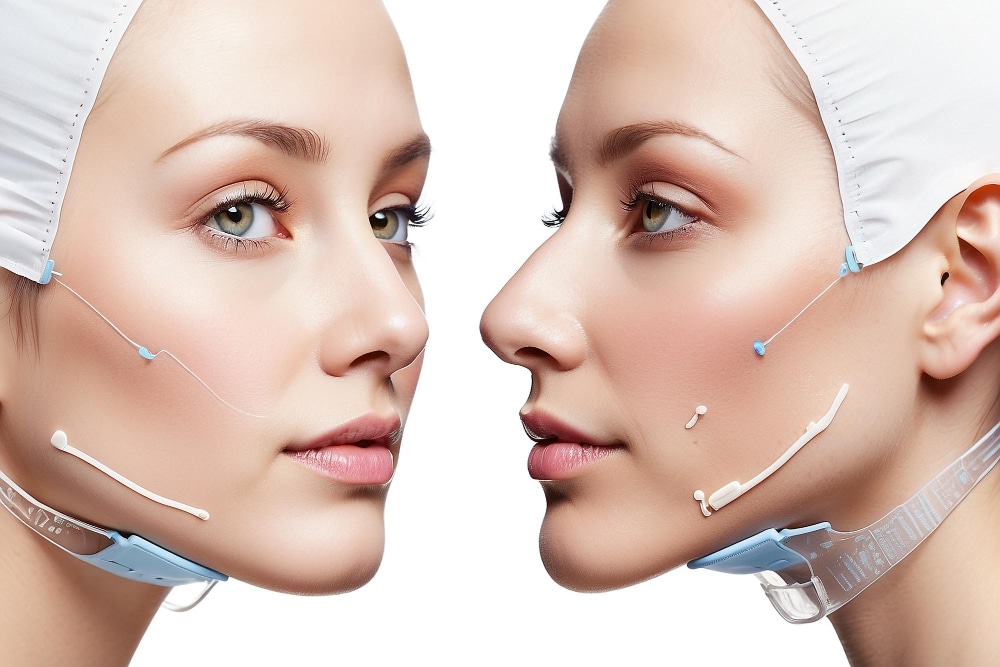
Get ready to elevate your skincare routine with a groundbreaking procedure! Introduced in the early 1990s, thread lifting has since taken the beauty world by storm, emerging as a sought-after alternative to traditional facelift procedures. This revolutionary technique is now embraced worldwide for its non-surgical approach to facial rejuvenation.
Modern advancements have transformed thread lifting, with dissolvable materials replacing traditional threads. These innovative materials are strategically inserted into the subcutaneous fat layer to provide targeted lifting effects. From the forehead to the neck and décolleté, thread lifting can address a range of areas, restoring youthful contours and enhancing natural beauty.
But the benefits don’t stop there! Some skilled practitioners also utilize threads to combat sagging in areas such as the arms, hands, knees, and buttocks, offering comprehensive rejuvenation from head to toe.
Join us as we delve into the world of thread lifting, exploring its transformative potential and unlocking the secrets to age-defying beauty.
Using sutures to help lift sagging skin is a minimally invasive technique for improving the elasticity and firmness of the skin. This treatment is recommended for patients with moderate sagging.
The practitioner will treat targeted areas with a local anesthetic before inserting the thread. The cones on the thread hold onto the tissue, which anchors the skin and holds it firmly.
Ever wondered how to turn back the clock on sagging skin without going under the knife? Look no further than. Try thread lift — a minimally invasive technique designed to restore skin elasticity and firmness. Ideal for those experiencing moderate sagging, this innovative treatment utilizes sutures to gently lift and rejuvenate targeted areas.
Here’s how it works:
Before the procedure, a local anesthetic is applied to ensure your comfort. The practitioner then strategically inserts threads equipped with tiny cones into the targeted areas. These cones anchor the skin tissue, providing a firm hold and lifting effect that’s both subtle and transformative.
Experience enhanced recovery with a minimally invasive technique:
While thread lifting offers several advantages, it’s essential to consider potential disadvantages associated with the procedure.
Limited Effectiveness on Excess Skin: While thread lifting can improve the appearance of sagging facial features by lifting and repositioning tissues, it may not fully address significant excess skin. Unlike surgical procedures like facelifts, which involve removing excess skin, thread lifting primarily focuses on lifting and tightening existing tissue. As a result, individuals with substantial excess skin may not achieve optimal results with thread lifting alone.
Temporary Nature of Results: Thread lifting typically provides temporary results. While the threads themselves dissolve over time, the lifting and rejuvenating effects they produce may gradually diminish as the threads dissolve and the skin’s natural aging process continues. Consequently, individuals seeking long-term facial rejuvenation may require repeat treatments or additional procedures to maintain their desired results.
Thread lifts are recommended for individuals with moderately sagging skin. Combining a thread lift with other non-surgical procedures can often provide the best outcomes. Patients may also consider using dermal fillers to hydrate and diminish facial lines post-thread lift.
Suitable candidates typically exhibit concerns such as a slightly undefined mandibular region, sagging cheeks, deep nasolabial lines, forehead wrinkles, a double chin, or lax neck skin.
Conversely, those with advanced facial lipoatrophy, excessive skin laxity, unrealistic expectations for immediate results, or a desire for outcomes comparable to traditional facelift surgery are not ideal candidates for thread lifts.
Thread lifts have become increasingly popular in recent decades for their ability to rejuvenate sagging skin. During the procedure, bioresorbable threads are inserted to lift the skin, with the threads gradually dissolving over time, prompting the body to produce natural collagen. While adverse reactions are uncommon, it’s crucial to seek treatment from a licensed practitioner to ensure safety and optimal results.
Frequent Side Effects Include:
Uncommon Side Effects May Include:
For individuals with moderate sagging, a thread lift presents an appealing option. While its effects are temporary, the boost in natural collagen production can contribute to ongoing skin enhancement.
The total expense varies based on the number of treated areas and the quantity of threads required. On average, patients can expect to pay between $1,500 to $4,500 for the procedure.
Additionally, some individuals choose to complement their thread lift results with dermal fillers, which typically range from $250 to $800 or higher depending on the product used. This combined approach offers a more cost-effective solution compared to traditional facelifts, which can exceed $15,000 in expense.

In recent times, there has been a notable surge in the popularity of thread lifting. With a growing awareness of its advantages and minimal risks, more patients are turning to this minimally invasive method for facial rejuvenation. Moreover, its affordability has made it an increasingly favored choice among individuals seeking alternatives to surgical facelifts.
Join our newsletter to receive latest news and offers

Medicle MD Ltd
Reg. Number: 14317237
Address: 27 Old Gloucester Street,
WC1N 3AX London,
United Kingdom
Our website is intended solely for people who use medical devices, such as dermal fillers, as professionals. It may contain product advertisements targeted only at such people. To enter Nu Derma Supply, please confirm that you are such a person (e.g. a medical professional, cosmetologist, service technician, etc.).